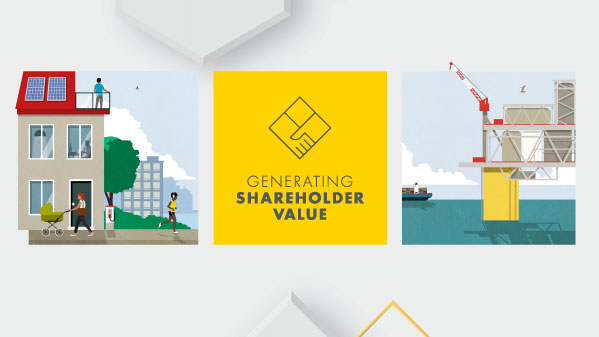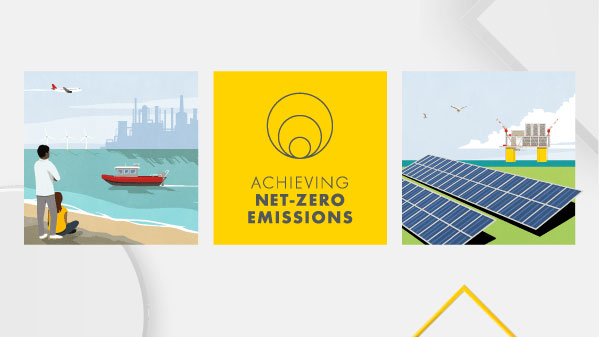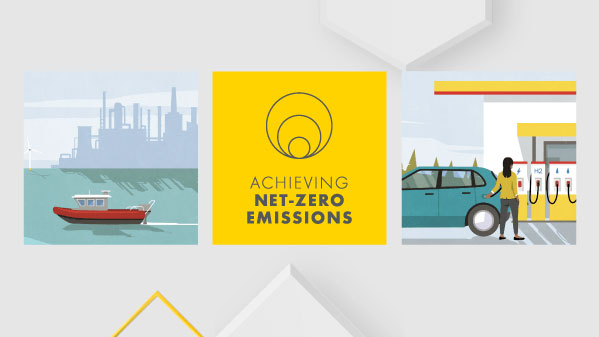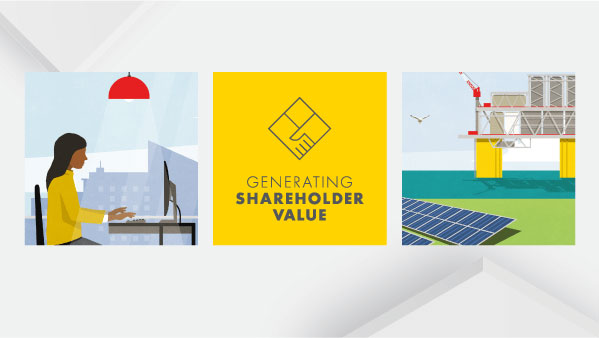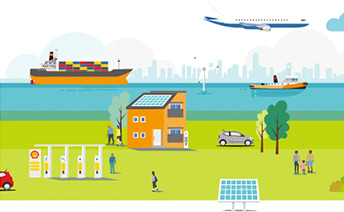Climate risk management
Shell’s processes for identifying and assessing climate-related risks
Identifying climate-related risks
As discussed in “Energy transition strategy”, Shell considers climate change and GHG emissions a material risk factor. We monitor the risks related to these across four components:
- commercial risks;
- regulatory risks;
- societal risks (including litigation risk); and
- physical risks.
These components are monitored and assessed on an integrated basis, necessitated by the interdependence of the risks and the related actions. The different components pose different kinds of exposures spanning different time horizons. Similarly, the responses to the components of the risk are also planned by taking a holistic view.
For example, the increasing cost of complying with emission limits in some regions is a regulatory risk that may require operational responses in the near term. The reduction in demand for legacy hydrocarbons is a commercial risk that may have a medium- to long-term impact, demanding changes to our strategic portfolio and business models. The risk of physical impacts of climate change may occur in the short, medium and long term and would require actions to mitigate adverse impacts on our assets and supply chain. As an example, the transformation of our refineries into energy and chemicals parks reduces the level of our operational emissions and medium- to long-term commercial risks, allowing us to plan for future adaptation measures.
Our integrated approach to risk management and the resulting changes in our strategy ensure we manage our aggregate climate change risk within our overall risk appetite over different time horizons.
- Shell’s processes for identifying and assessing risks are part of our Shell Control Framework.
- Our risk management procedures that help us identify climate-related risks and opportunities include:
- monitoring external developments, including policy changes and new regulations;
- evaluating the status of risk indicators, which illustrate how well we are managing each component of the risk related to climate change and GHG emissions; and
- learning from incidents and assurance findings.
We use these procedures to identify risks relating to climate change and GHG emissions, which in turn enables us to determine their significance, both individually and relative to other risks.
Assessing climate-related risks
Processes within the Shell Control Framework that help us assess each identified risk include the evaluation of its impact, likelihood and the level of risk we are willing to accept.
When assessing the likelihood of a risk occurring, we consider factors such as our ability to prevent the risk happening and whether the risk has materialised in the past.
We consider the financial consequences and how it might affect our reputation, our ability to comply with regulations, and possible damage to health, safety, our assets and the environment. The impact, and hence materiality, of a risk is based on how critical it could be to our business model.
We operate in multiple countries and therefore societal risks are material as they are directly linked to our licence to operate.
The impact and likelihood assessment helps us to prioritise risks and determine their relative materiality, based on a comprehensive picture of significant risks to a relevant business’s objectives.
To support our risk assessments, we seek to establish the level of risk that we are willing to accept in pursuit of Shell’s strategy and objectives. We consider the amount of resources – such as financial resources, people, processes, systems and controls – that we are willing and able to allocate to manage each risk in pursuit of our objectives and the impact to Shell’s overall risk profile.
The impact and likelihood assessment, combined with risk appetite, determines the type of risk responses, such as controls and assurance activities, that may be required to manage each risk.
Possible responses include:
- accepting the risk without any further action;
- mitigating or reducing the risk with appropriate controls, supported by assurance activities;
- transferring the risk, for example to insurance providers where appropriate; and
- altogether stopping or forgoing the activity that gives rise to the risk.
In determining our risk responses, we always seek to comply with our Code of Conduct and other boundaries, such as our financial framework, which set the aggregate level of risk appetite that could be sustained. The financial framework considers boundaries such as our net debt levels and our credit rating.
Physical risks
Potential physical impacts to our assets, irrespective of cause, are important for us to manage.
Climate variability is considered in the design and operation of our assets and infrastructure to minimise the risk of adverse incidents to our employees and contractors, the communities where we operate, our equipment and infrastructure. Our new projects consider anticipated weather and climatic events in their design and Metocean (meteorology and oceanography) engineering experts are available, if requested, to assist our assets and project teams in the evaluation of physical risks.
On an ongoing basis, our assets leverage broad risk and threat management processes to identify and respond to emerging challenges to their ongoing safe, compliant and efficient operation, as required by our HSSE & SP Control Framework. We are working to deepen our understanding of this risk and to establish metrics in this area to monitor our exposure across the Group.
Classifications of risks
We identify and assess three distinct categories of risk across the Group:
- strategic: we consider current and future portfolio issues, examining parameters such as country concentration or exposure to higher-risk countries. We also consider long-range developments in order to test key assumptions or beliefs in relation to energy markets.
- operational: we consider material operational exposures across Shell’s entire value chain to provide a more granular assessment of key risks that the organisation is facing.
- conduct and culture: we consider alignment of our policies, practices and behaviours against our purpose and core values.
The four sub-components of risk related to climate change and GHG emissions – commercial, regulatory, societal (including litigation), and physical risks – are assessed across the above three categories to ensure we maintain strategic resilience, have robust day-to-day operational risk responses and that responses align with Shell’s purpose and core values.
Shell’s processes for managing climate-related risks
Our climate-related risk management process is carried out at the Group, business, function and asset level, which includes projects.
We apply the Shell Control Framework to ensure that we effectively manage our climate-related risks at all these levels. The framework includes:
- mandatory risk standards and manuals;
- project-level risk management processes;
- management and Board reviews;
- internal audits and investigations; and
- annual attestation processes.
Mandatory risk standards and manuals
We have mandatory standards and manuals which establish the requirements on how to effectively manage material risks including the operation of appropriate controls. Our standards and manuals also provide guidance on how to monitor, communicate and report changes in the risk environment. These documents aim to:
- ensure consistent management and assessment of climate risk across Shell;
- clarify expectations for risk management and reporting, including roles and responsibilities of the risk owners;
- clarify types of assurance activities that may be applicable;
- strengthen decision-making by ensuring that businesses have better awareness and understanding of climate risks (including their likelihood and potential impact) and mitigation plans; and
- enable integration of Shell’s reporting.
We periodically review and, if necessary, update our standards and manuals in light of developments in risks, including those associated with climate change. Our approach continues to evolve as we increase our understanding of changing policies and the differing pace of energy transition in different regions.
Project-level risk management processes
At a project level, assessing climate-related risks is an important part of making initial investment decisions. Projects of a certain size or which carry unusual risks are required to follow Shell’s Opportunity Realisation Standard, which sets out the rules for managing and delivering opportunities in the organisation. Each project is assisted by experts from our global subject matter groups during its development, implementation and operation.
Projects under development that are expected to have a material GHG impact must meet our internal carbon performance standards or industry benchmarks. Our performance standards are used for measuring a project’s average lifetime GHG intensity or energy efficiency per asset type. Applying these criteria ensures that our projects can compete and prosper in the energy transition. An exception process is in place to manage specific incidental cases. Performance standards are under development for power and hydrogen projects.
The performance standards are approved by the Executive Vice President accountable for implementation in the relevant businesses, and by the Executive Vice President Safety, Environment and Asset Management.
Projects with a material GHG footprint that meet the performance standards or industry benchmarks will often set more ambitious emissions targets for themselves. GHG abatement plans help determine the nature of these targets, and we assess the effects of a project’s emissions alongside economic and technical design factors.
We assess the future GHG emissions of projects against performance standards and by considering the GHG emissions from the use of the products that are to be manufactured. These assessments can lead to projects being stopped or designs being changed.
We expect the performance standards to evolve as our portfolio changes in the energy transition.
Management and Board reviews
Management, the Board and Board committees review the risk of climate change and GHG emissions to ensure awareness of emerging issues that may impact our strategy and to ensure the effectiveness of our responses in managing this risk at a more granular, operational level. For example, as part of the annual planning cycle, the Executive Committee and the Board assess how climate change and GHG emissions may affect the pace of the energy transition, business emission reduction plans and the implications for Shell’s current portfolio.
In addition, each business and function regularly reviews its risk profile, risk responses and assurance activities throughout the year to ensure climate-related risks are managed effectively. These insights are used to provide management with updates on the operational management of climate change and GHG emissions risks. During these updates, management considers the significance of the climate change and GHG emissions risks relative to other risks on the Group risk profile and reviews whether our risk responses are effective in addressing the four sub-components of the climate change and GHG emissions risk.
Our management reviews help us to update Shell’s plans and guide our day-to-day operational decisions such as maintenance schedules and our risk response plans.
Internal audits and investigations processes
Shell’s Internal Audit and Investigations (SIAI) team provides independent and objective assurance and advises management and the Board on the adequacy and effectiveness of our risk management and internal controls.
For example, SIAI conducted four GHG audits during 2022 to test whether controls are adequately designed and operating effectively to mitigate the identified risks. The controls tested covered GHG emissions measurement, reporting and forecasting and abatement projects. Additionally, SIAI conducted two audits focused on decarbonisation of industry sectors and nature based solutions.
Annual attestation processes
On an annual basis, all directors are required to provide an attestation of their business’s or function’s compliance with our HSSE & SP Control Framework and to report this to Shell’s CEO. This includes the assessment of the effectiveness of the internal controls in managing climate-related risks.
Project-level risk management in action:
Shell Energy and Chemicals Park Singapore
We are transforming our refining business and making it fit for the future. The Pulau Bukom Manufacturing Site in Singapore transformed into the Shell Energy and Chemicals Park Singapore. We have reduced our crude processing capacity by about half and delivered a significant reduction in CO2 emissions.
We are repurposing Bukom by making significant changes in our refinery configuration, establishing a foundation for producing low-carbon energy products like biofuels. We are also incorporating circularity, such as waste plastics for feedstock, as well as providing renewable energy.
Integration of the climate-related risk management process into Shell’s overall risk management
Our climate-related risk management process follows the approach set out by the Shell Control Framework, ensuring that it is integrated into the overall risk management processes of the Group.
Climate-related risks are considered from a strategic and operational perspective to ensure we maintain a comprehensive view of the different types of climate risks we face and the different time horizons in which they may affect us.
The monitoring and review of risks is a key risk management process in Shell. The Executive Committee, the Board and Board committees review climate-related risks and their impact on the Group. This allows management to take a holistic view and to optimise risk mitigation responses, to ensure that climate-related risk responses are properly integrated into the relevant activities.

